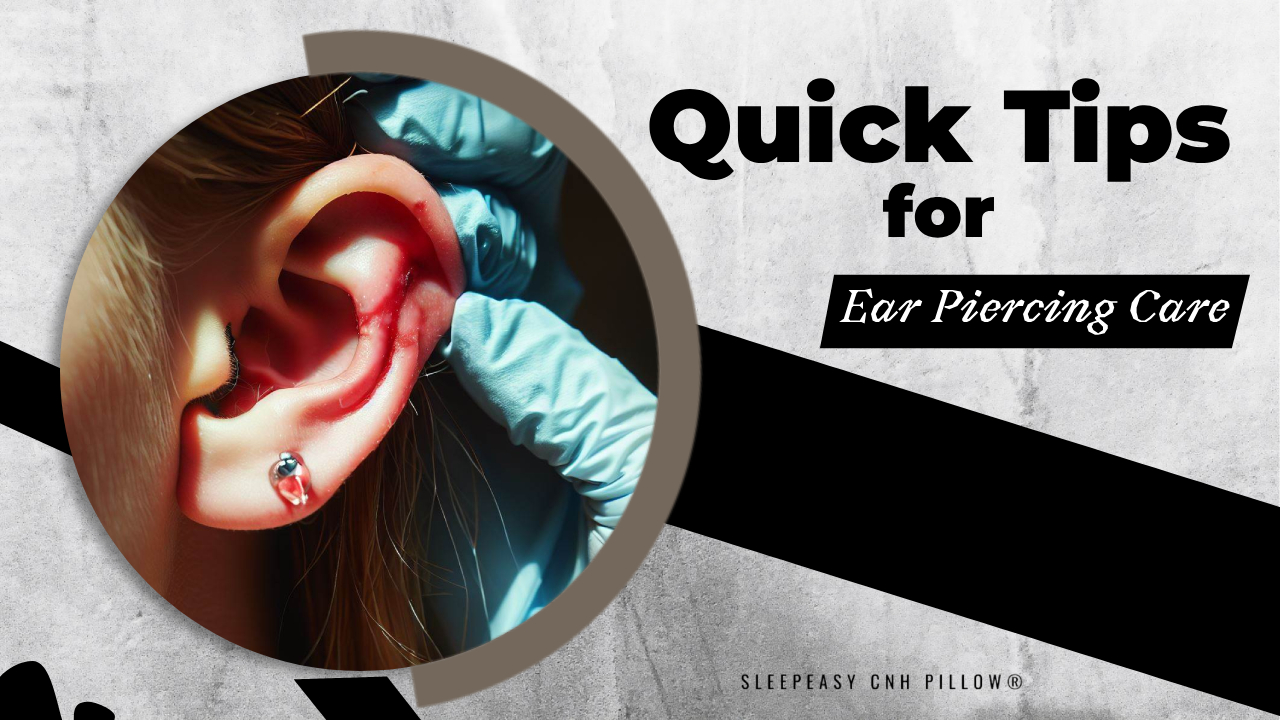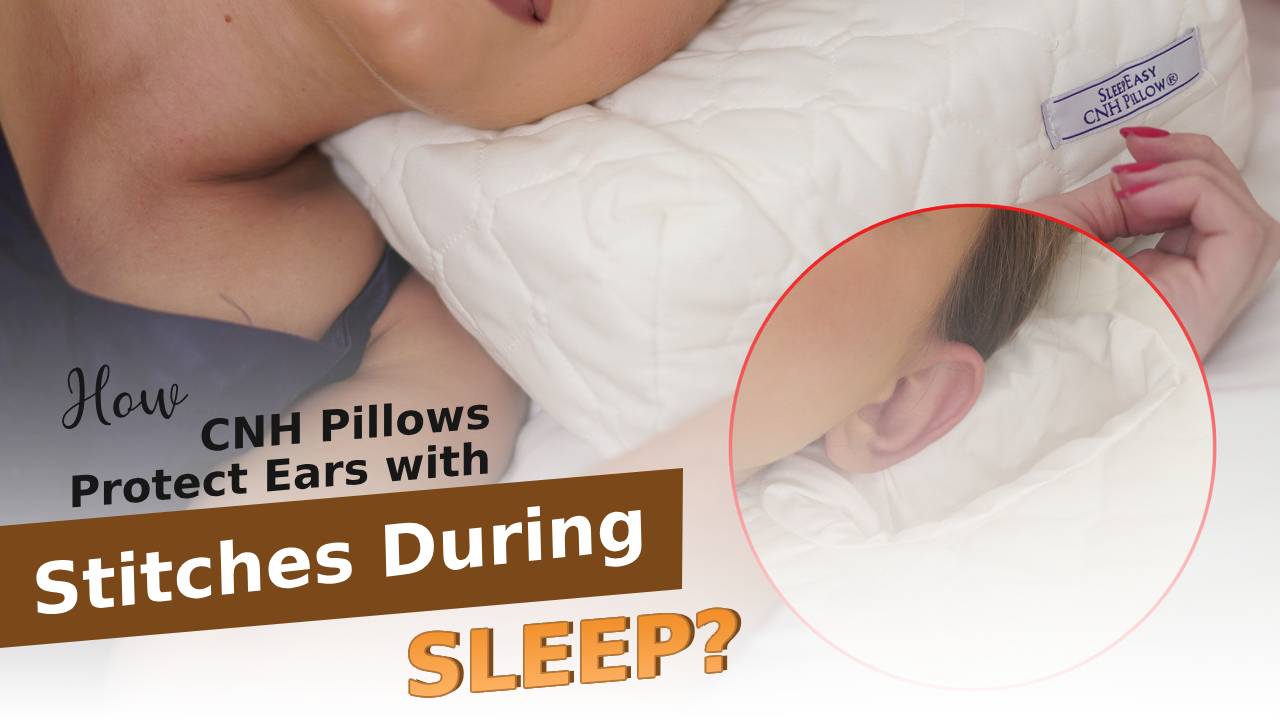Quick Ear Care Tips with Ear Piercing Pillow
Oct 22nd 2023
Getting a new ear piercing is exciting, but proper aftercare is essential to ensure smooth healing and prevent complications. One of the most overlooked yet effective tools in the healing process is the ear piercing pillow, a specially designed cushion that reduces pressure on the ear while you sleep. Whether you have a lobe, cartilage, or industrial piercing, combining smart aftercare practices with the right sleep pillow for ear piercing can significantly speed up recovery and enhance comfort.
This guide by CNH Pillow provides quick, expert-backed tips on how to care for your new piercing using an ear healing pillow or piercing aftercare pillow. From proper cleaning techniques and hygiene best practices to selecting the ideal pillow for side sleepers with piercings, CNH Pillow helps you create a sleep-friendly routine that protects your piercing and promotes faster healing. With the right tools like an ear piercing comfort cushion from CNH Pillow you can sleep soundly while supporting your body’s natural healing process, ensuring both comfort and care throughout your recovery journey.
Keynotes
- Monitor for signs of infection: such as redness, throbbing pain, excessive swelling, fever, warmth around the area, or yellow/green discharge.
- Clean the piercing twice daily: using a sterile saline solution or a mild, alcohol-free antibacterial cleanser — avoid using hydrogen peroxide or harsh soaps.
- Avoid touching your piercing with unwashed hands: to reduce the risk of introducing bacteria and causing irritation or infection.
- Sleep on a specialized ear piercing pillow: or a soft ear healing pillow to avoid pressure and friction, especially if you’re a side sleeper.
- Do not remove or rotate the jewelry unnecessarily: especially during the early healing phase, as this can delay recovery and increase infection risk.
- Keep hair, makeup, and skincare products away: from the piercing area to prevent contamination and clogged skin around the site.
- Choose hypoallergenic earrings: such as surgical steel or titanium, to reduce the chance of allergic reactions and inflammation.
- Be cautious with hats, headphones, or helmets: that may rub against or irritate the new piercing.
- Consult a healthcare professional immediately: if you experience worsening symptoms, such as a stuck earring, fever, increased swelling, or spreading redness.
- Stick to your aftercare routine consistently: even if the piercing looks healed on the outside — it can still be healing internally.
Ear piercings are a timeless form of self-expression, whether you choose a classic lobe piercing or a more unique style like a cartilage, helix, or tragus. However, achieving a smooth and complication-free healing process requires proper aftercare from day one. Keeping your new piercing clean is essential to prevent infection, irritation, and delayed healing. In this guide, we’ll cover the essential steps for cleaning and caring for your ear piercing, along with expert tips to promote comfort, hygiene, and faster recovery throughout the healing journey.
What to Know Before Getting Your Ears Pierced
Before getting your ears pierced, it’s important to be well-informed and prepared to ensure a safe and smooth experience:
- Choose a Licensed Professional: Always go to a reputable piercer who follows strict hygiene protocols and uses sterile, single-use needles—never a piercing gun, especially for cartilage.
- Select Safe, High-Quality Jewelry: Opt for materials such as surgical stainless steel, implant-grade titanium, niobium, or hypoallergenic gold to minimize the risk of allergic reactions or irritation. Avoid low-quality metals like nickel.
- Know the Healing Timeline: Healing times vary by piercing type. Lobe piercings may heal within 6–8 weeks, while cartilage piercings can take several months. Be patient and don’t rush the process.
- Commit to Aftercare: A successful piercing requires a consistent aftercare routine — this includes daily cleaning, avoiding unnecessary touching, and protecting the piercing from friction while sleeping or wearing accessories.
- Understand Potential Risks: Be aware of possible complications like infection, keloids, or embedded jewelry, and know when to seek professional help.
- Plan Your Timing: Avoid getting a new piercing right before events, travel, or activities that may interfere with healing (e.g., swimming, wearing helmets, or sleeping on that side).
How to Clean a New Ear Piercing
Proper cleaning is key to preventing infection and ensuring your new ear piercing heals safely. Here’s how to care for it the right way:
- Wash Your Hands First: Always start by thoroughly washing your hands with soap and water to avoid introducing bacteria to the piercing site.
- Use a Saline Solution: Clean your piercing twice daily using a sterile saline solution or as recommended by your professional piercer. Avoid homemade solutions unless advised.
- Clean Gently: Soak a clean cotton pad or gauze in the solution and gently cleanse both the front and back of the piercing. Do not twist, turn, or move the jewelry while cleaning.
- Rinse & Pat Dry: Rinse the area with clean, lukewarm water to remove any residue, and gently pat dry using a disposable paper towel — not a cloth towel, which may harbor bacteria.
- Minimize Touching: Avoid touching or playing with your piercing throughout the day, especially with unwashed hands.
- Avoid Harsh Products: Do not use alcohol, hydrogen peroxide, or ointments, as these can irritate the skin and delay healing.
- Follow Professional Aftercare: Always adhere to the specific aftercare guidelines provided by your piercer, as each studio may have recommendations based on piercing type and location.
How to Treat an Infected Ear Piercing
Even with proper care, ear piercings can sometimes become infected. If you notice signs like redness, swelling, warmth, pain, or discharge, here’s what you should do:
- Do Not Remove the Jewelry: Keep the jewelry in place unless advised otherwise by a medical professional. Removing it too soon can cause the piercing to close up and trap the infection inside.
- Seek Professional Advice: Contact a professional piercer or healthcare provider for evaluation. In more serious cases, a doctor may prescribe topical or oral antibiotics.
- Continue Gentle Cleaning: Maintain your cleaning routine using a sterile saline solution. Avoid using alcohol or hydrogen peroxide, which can worsen irritation.
- Avoid Touching or Twisting: Keep your hands off the piercing unless you’re cleaning it, and never twist or turn the jewelry while it’s healing.
- Monitor Your Symptoms: If you experience increased pain, spreading redness, fever, or the infection doesn’t improve within a few days, seek medical attention immediately.
How to Tell If Your Piercing Is Infected
Recognizing the early signs of an infected piercing is essential for prompt treatment and preventing complications:
- Common Symptoms: Watch for persistent redness, swelling, warmth around the area, throbbing pain, or tenderness. Yellow, green, or foul-smelling discharge and the presence of a fever are also clear indicators of infection.
- Unusual Discomfort: If the pain increases rather than improves over time, or if the area becomes increasingly sensitive, it may be infected.
- Seek Professional Guidance: If you notice any of these symptoms, contact a professional piercer or healthcare provider promptly for an accurate diagnosis and appropriate care.
When Can You Safely Change Your Piercing Jewelry?
Switching out your jewelry too early can irritate the piercing, delay healing, or even lead to infection. Always follow professional advice and ensure the piercing is fully healed before making changes.
Lobe Piercings
Typically heal within 6 to 8 weeks, after which you may be able to change your earrings. However, it's always best to confirm with your piercer before switching to new jewelry.
Cartilage Piercings
Require a longer healing period usually 3 to 6 months, depending on your body and how well you’ve followed aftercare instructions. Some cartilage piercings may take up to a year to fully heal.
General Tip
If there’s still tenderness, redness, or discharge, avoid changing the jewelry and continue with aftercare until symptoms resolve.
Additional Tips for Ear Piercing Care and Comfort
Caring for a new ear piercing goes beyond cleaning; it's also about minimizing discomfort and supporting the healing process. Here are a few helpful tips to make your recovery smoother:
- Pain & Pressure Relief: To reduce discomfort while sleeping, use an ear piercing pillow or foam pillow with a hole. These specially designed pillows offer soft, targeted support by keeping pressure off the piercing site — ideal for side sleepers or anyone experiencing tenderness.
- Stay Hydrated & Rested: Proper hydration and quality sleep support your body’s natural healing response.
- Avoid Tight Accessories: Refrain from wearing tight hats, headphones, or anything that may rub against or put pressure on the piercing area.
- Maintain a Clean Sleep Environment: Change pillowcases frequently and avoid sleeping on dirty surfaces to minimize the risk of infection.
- Be Patient: Healing takes time — resist the urge to change jewelry too soon or touch the piercing unnecessarily.
Extra Tips for Ear Piercing Aftercare and Healing
Supporting your new piercing with the right habits is just as important as cleaning it. Follow these extra care tips to ensure a smoother, irritation-free healing process:
Avoid Sleeping on the Pierced Side
Pressure from sleeping on your new piercing can cause irritation, swelling, or delayed healing. Use an ear piercing pillow to relieve pressure if you're a side sleeper.
Maintain a Healthy Lifestyle
Staying hydrated, eating well, and getting enough rest can significantly support your body’s natural healing response.
Avoid Swimming
Keep out of pools, hot tubs, lakes, and oceans until your piercing is fully healed to prevent exposure to bacteria, chlorine, and contaminants.
Keep Hair and Hair Products Away
Long hair can tangle with jewelry and introduce bacteria. Avoid applying hairspray, dry shampoo, or dyes near the piercing site.
Protect from UV Exposure
If your piercing is exposed to sunlight, apply a gentle, non-irritating sunscreen once the wound has closed. UV rays can slow healing and darken scar tissue.
Consult a Professional if Needed
If you experience persistent redness, swelling, discharge, or sharp pain, don’t hesitate to contact your piercer or a healthcare provider.
By combining these practical tips with a consistent aftercare routine, you can support a healthier, faster, and more comfortable healing experience. Remember patience, hygiene, and protection are the pillars of successful ear piercing care.
Conclusion
Getting a new ear piercing is an exciting form of self-expression but it also comes with the responsibility of proper care. A successful healing journey requires consistency, patience, and attention to hygiene. From choosing high-quality jewelry to following a thorough aftercare routine, every step plays a crucial role in protecting your piercing from irritation or infection. Enhancements like an ear piercing pillow can add extra comfort, especially for side sleepers, while sun protection and clean sleep habits support faster healing. With the right care, your piercing will remain a stylish and healthy part of your look for years to come. Embrace the process and wear your new piercing with pride and confidence.
Frequently Asked Questions
Do piercing pillows really work?
Yes, piercing pillows can be very helpful during the healing process. They provide a soft and supportive surface that reduces pressure and friction on fresh piercings—especially ear piercings. While not absolutely essential, they can significantly minimize irritation, swelling, and prolonged healing caused by pressure during sleep.
Is it okay to sleep on your piercing?
It’s best to avoid sleeping directly on a new piercing. Doing so can cause discomfort, irritation, or even migration (when the piercing moves out of position). Use a clean, soft pillowcase or a donut-shaped piercing pillow to keep the area elevated and protected while you rest.
How do you use a piercing pillow correctly?
Place the piercing pillow under your ear with the hole aligned to the piercing site so that the jewelry doesn’t touch the surface. This helps reduce friction, prevents snagging, and allows proper airflow, promoting faster healing.
How long should I use a piercing pillow after getting pierced?
Most people find it helpful to use a piercing pillow for the first 4–8 weeks after getting pierced. The exact duration depends on the type of piercing and how quickly it heals. Continue using it until you can comfortably sleep without irritation.
Can I make a DIY piercing pillow at home?
Yes, you can create a simple piercing pillow at home using a small travel pillow or by cutting a hole in the center of a soft cushion. However, ensure it’s clean and made from hypoallergenic materials to avoid infection or allergic reactions.
Are piercing pillows safe for all types of ear piercings?
Piercing pillows are ideal for cartilage, helix, tragus, and conch piercings—anywhere pressure from normal pillows could cause discomfort. They are less necessary for body piercings that don’t come into contact with sleeping surfaces.
How do I clean a piercing pillow?
Clean your piercing pillow regularly by removing the cover (if detachable) and washing it with a gentle detergent. If it doesn’t have a removable cover, spot-clean with a mild antibacterial solution. Always keep it dry and hygienic to prevent bacteria buildup.
Can I use a regular travel pillow instead?
Yes, a U-shaped travel pillow can serve the same purpose. Position it so your ear or piercing fits comfortably in the hollow center, avoiding pressure on the healing area.
What materials are best for piercing pillows?
Look for pillows made from memory foam or hypoallergenic microbeads, with a soft, breathable cotton or bamboo cover. These materials help maintain comfort, hygiene, and airflow—key factors for proper healing.
Do piercing pillows help reduce swelling or infection risk?
While they don’t directly treat swelling or infection, piercing pillows help prevent the aggravation that often leads to these issues. By reducing contact and friction, they create a cleaner, less irritated environment for healing.



